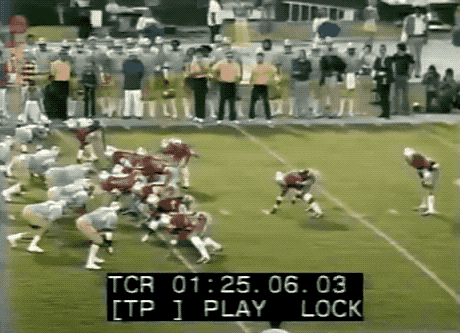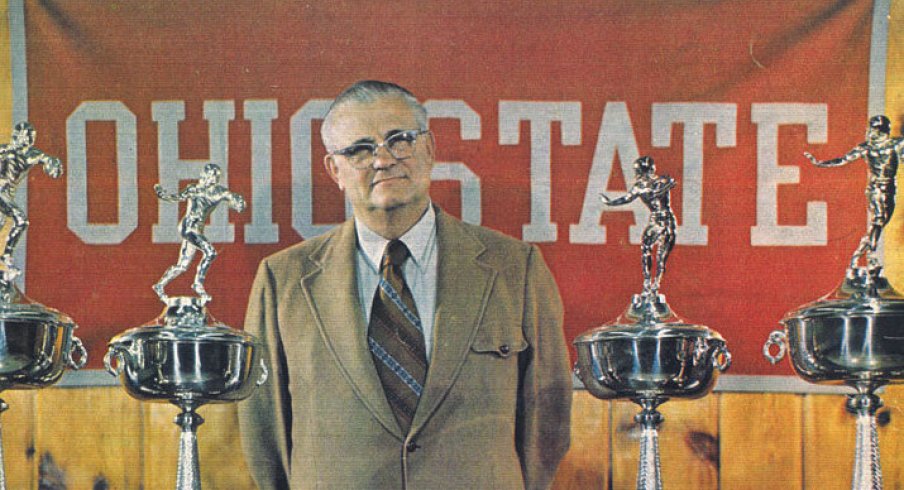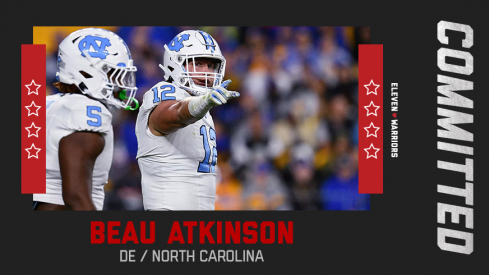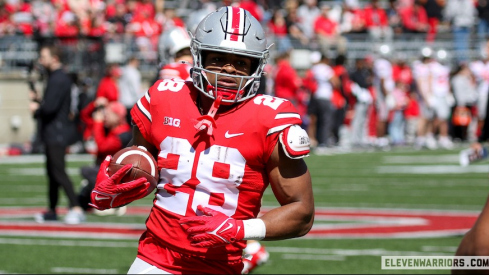With three national championships in his first 11 seasons at Ohio State, Woody Hayes had made the Buckeyes one of America's most respected and well-known programs.
But after pummeling opponents for a decade with his "three yards and a cloud of dust" offense running out of the old 'T-formation,' the Buckeyes lingered in mediocrity for the first time in Hayes' career. From 1962-67, Ohio State failed to win a single conference title and losing at least two games per season, bottoming out in 1966 with a 4-5 record.
There were a number of factors that pulled Hayes' program back down from the top of the mountain. Attracting only in-state players meant Hayes couldn't match the talent found on other powerhouse programs that had begun to recruit nationally. Spurred by the worst season in his career since his initial 2-6 campaign at Denison University 20 years prior, Hayes spent the winter of 1967 expanding his scouting footprint, bringing in out-of-state talents like Jack Tatum, John Brockington, Jan White, and Tim Anderson, all of whom would go on to plant All-American trees in the Buckeye Grove.
But Hayes also needed to look inward. Though his T-formation system certainly brought great success, its biggest downside may not have been its conservative nature, but its rigidity. There was little room to accommodate the talents of any specific individual, as evidenced by the first true star Hayes ever coached.
Vic Janowicz won the Heisman trophy in 1950 as the focal point of Wes Fesler's single-wing offense, running, throwing, and kicking his way to nearly 1,000 yards of offense at a time when such a feat was rare. Yet once Hayes arrived the following season, Janowicz was assigned to play left halfback, severely limiting his touches and ability to affect the game. The reigning Heisman-winner rushed for 376 yards and threw for only 74 more as his team went a mediocre 4-3-2 in Hayes' inaugural season in Columbus.
A decade later, little had changed. Paul Warfield would go on to become one of the greatest receivers in NFL history, catching 427 career passes and going to eight pro bowls before earning a spot in the Pro Football Hall of Fame. Yet as a member of Hayes' Buckeyes from 1960-63, Warfield was a glorified blocker as a halfback in the T, never gaining more than 540 yards from scrimmage or scoring more than six touchdowns in a season from his fixed role in the OSU system.
The focal point of Woody's T-formation system was the fullback, a big-bodied bruiser who rammed forward into the mass of bodies between the tackles, picking up efficient, though rarely extended, gains from scrimmage. Athletic ball-carriers that thrived in open space were accessories, used as decoys on fake sweeps around the end that posed less of a threat as time wore on.
In 1967, Purdue hammered the Buckeyes at home, 41-6, as Boilermakers coach Jack Mollenkopf took a seat on the bench during the second half, knowing his victory was secure as Woody's offense wasn't built to come back from such a deficit. Hayes took Mollenkopf's actions as the ultimate insult, determined to get revenge once his talented group of sophomores took the field the following fall.
But the biggest addition to Woody's program that autumn may not have been the talents of Tatum, Brockington, and the rest of the 'Super Sophomores.' Though Woody had a keen eye for hiring some of the game's best coaches to be his assistants, such as Bo Schembechler, Ara Parseghian, Lou Holtz, Joe Bugel, Bill Mallory, and Earl Bruce, one of the most influential staff members to join Hayes' staff was a former Pennsylvania high school coach named George Chaump.
Chaump joined the program in 1967, and immediately tried to get the old man to change his ways. While the Buckeyes had been toiling in mediocrity throughout the mid-60s, Southern Cal was busy winning championships and establishing itself as one of the nation's pre-eminent programs, thanks in large part to their I-formation offense.
Instead of featuring a physical fullback that was certain to pick up a few yards at a time the way Hayes did in the T, the I put an athletic halfback in the spotlight, attacking every potential gap on the field with handoffs and tosses and turning the fullback into a human bulldozer tasked with leading the way. Trojan halfbacks Mike Garrett and O.J. Simpson thrived in the system, winning Heisman trophies and re-defining the running back position.
Don Coryell, who would go on to become one of the most innovative minds the game has ever seen with his vertical passing game, implemented the I-formation in Los Angeles for head coach John McKay. Coryell's offense gave the halfback time to read the defense and hit holes as the play developed instead of ramming straight into a pre-defined spot, whether it was filled by a defender or not.
But not only did the system change the backfield's alignment, it spread out the defense further by including receivers split out wide along with a tight end, providing three passing targets on every snap. Chaump believed the system would be ideal for his new team, having seen the athleticism of the new recruits, but his boss was set in his ways.
As noted in A Fire to Win - The Life and Times of Woody by John Lombardo,
“Woody thought it was illegal to use three receivers,” Chaump said. “But I was battling to throw the ball.”
The more experienced coaches chuckled under their breaths. The idea of moving away from his “three yards and a cloud of dust” offense was heresy.
“Woody was tight as hell and was dead set against using the I– formation, and he got so mad at me for suggesting it, and he fired me on the spot,” Chaump said. “He said it would never work, that it would make the fullback a glorified guard, and he wasn’t going to change his reputation and ruin his image by listening to some high school coach who never coached a college game in his life. I couldn’t believe it, but I got up to leave, but then he told me to come back and sit down.”
But though they had been hesitant early on, fellow assistant coaches Hugh Hindman, Tiger Ellison, and Earle Bruce slowly bought into the idea, helping to thaw their boss' views on such a radical change. Eventually, Hayes relented and allowed his young staff to install the system in the spring of 1968.
The change in philosophy paid off immediately, as Ohio State cruised to a 35-14 opening day win over SMU in which the Buckeyes rushed for 227 yards while throwing for 139 yards on 8 of 14 completions. Led by a star three-sport athlete in Rex Kern at quarterback, Hayes' new offense thrived early, amassing over 400 yards of offense in a revenge upset win over Purdue, who had entered the game as the country's top-ranked team.

Gone were the predictable and compact T-formation concepts that rarely attacked the edges, replaced by a (relatively) wide open attack that spread the defense horizontally with outside tosses to Brockington and options allowing Kern to read the defense like the point guard he'd originally dreamt of becoming.
Unlike Woody's primitive passing offense in the T-formation which was based entirely off play-action fakes, the Buckeyes now included a dropback passing game for the first time since Janowicz had operated from the single-wing two decades prior. With two receivers split wide and a tight end or running back releasing to the middle, the defense was stretched like they had never been before when facing the Buckeyes, leaving opponents reeling.

But the new offensive stars failed to impress their paranoid coach, who became more and more frustrated by their inability to put lesser teams away as the season wore on. Despite an undefeated record, Hayes abandoned the I-formation with two games remaining in the season, going back to the T-formation that had been kept for use inside the opposing 20-yard line.
The Buckeyes' undefeated campaign held through victories over Michigan at home and USC in the Rose Bowl, beating the same I-formation with Simpson in the backfield that had inspired Chaump before the season. Not only was Hayes once again a national champion, nearly all of his team was returning the following season to make a run at a repeat. While the offense's execution in the I-formation had been spotty at points, Chaump and the other staff members once again convinced their boss to go back to the system in 1969, certain such a talented group could master the concepts now that they had gained the game experience Hayes so valued.
Throughout much of the 1969 season, the Ohio State offense rolled through opponents like never before, averaging over 500 yards of offense and 46 points per game as they headed into the regular season finale in Ann Arbor. Of course, the Buckeyes would sleepwalk through one of the most famous upset losses in school history, as Hayes' former player and assistant Bo Schembechler led his troops to a shocking 24-12 win.
The loss haunted Woody, feeding his paranoia as the wide-open offense was responsible for six interceptions that day. The risk was too great to continue with the I-formation in his view, despite the fact that it had re-written the record books over the past two seasons.
Yet as the team met in 1970 with the class of Kern and Brockington heading into their final season on campus, the I-formation was gone, replaced by the predictable and conservative T. Opposing coaches were stunned, as the Buckeyes had given up on a proven system that was nearly unstoppable when the talent on hand was reaching its peak level of performance.
According to A Fire to Win,
“After we got beat in nineteen sixty-nine our offense shrunk,” Kern said. “So we went from the wide-open offense that was unpredictable to a very predictable offense, to where we were running the ball forty-two times a game.”
...
“[Purdue coach] Alex Agase told me, ‘We were so scared of you guys after what you did in nineteen sixty-nine, until we saw Woody come out with the offense. We couldn’t believe it. The old man was back to running a Model T,”’ Kern said.
The team would still go undefeated in the regular season, thanks in large part to the efforts of a stellar defense that featured countless stars like Tatum, Jim Stillwagon, and Mike Sensibaugh, winning games that were much closer than the year before. Yet despite being crowned as national champions by the National Football Foundation before the bowl season, the Buckeyes would blow a fourth-quarter lead in the Rose Bowl, even after rushing for 380 yards that afternoon against Stanford. The loss was only their second in three years, both costing Hayes and the team consensus national titles.
Nineteen seventy-one was a rebuilding year with so much talent to replace, and no offensive system could've saved Hayes' team from their 6-4 record. The following season, however, was different. By then, the I-formation was back once again, having been adopted widely at every level of the game and proving its viability to the old coach.
Against North Carolina in the second game of 1972, a fifth-string freshman tailback named Archie Griffin seized a rare opportunity at playing time, galloping for a school-record 239 yards in the Horseshoe and setting the stage for what was to come over the next four years. Archie was a perfect fit in the I; a shifty back that was patient enough to let his blocks set up before bursting through the hole and hitting top speed quickly.

The Buckeyes would go on to a 7-2 record, losing a close one to Michigan State on the road before heading to Pasadena and falling to an experienced and talented USC team. But the table had been set perfectly for the 1973 campaign, as Griffin would headline a backfield whose talents were perfectly suited for the I.

Though senior co-captain Greg Hare looked the part of an All-American quarterback, flashy sophomore Cornelius Greene would surprise everyone by keeping the job after Hare returned from a hamstring injury suffered in training camp. There was little reason to doubt the decision, as Greene was a perfect fit as an option quarterback from the I, giving Hayes two explosive players that could take it to the house at any time.
Hayes couldn't look back now, as his offense was clearly best-suited to operate with Griffin at the tailback spot, and if not for a 10-10 tie with Michigan, would've been crowned national champions after the 1973 season. Greene had jammed his thumb in the week leading up to the matchup with Schembechler and the Wolverines, and on a cold, rainy day the conservative Hayes gave in to his paranoia once again, ignoring the advice of his assistants and putting the wraps on the offense after amassing a 10-0 lead. Eventually, his arch-rivals would catch up after it became clear the Buckeyes' game plan simply consisted of inside handoffs to Griffin and fullback Pete Johnson while Greene would only throw one pass throughout the entire game.
Despite the tie, the Big Ten athletic directors still voted to send Ohio State back to the Rose Bowl, but Woody's coaches nearly didn't make the trip. After the debacle in Ann Arbor, Chaump and the others were furious that Hayes had fallen into old patterns and would only agree to stay on with the team if their boss agreed to open things back up against USC in the bowl game.

Unknownst to the players, Hayes would finally follow the advice of his assistants, putting together an aggressive game plan that called for a great deal of passing. To his credit, Woody held to his word, allowing Greene to throw the ball all over the field after an opening drive interception. The quarterback would win MVP honors that day as the balanced attack ravaged the Trojans in a 42-21 win.
After back-to-back Rose Bowl appearances, Hayes relented to the success his team had found with a balanced attack from the I, leading to the most successful extended stretch of his career. From 1968-77, Woody's teams would only miss out on a Big Ten title once (1970) and played in six Rose Bowls while also making the first Sugar and Orange Bowl appearances in school history.
More notably, Griffin would become a national icon with his two Heisman trophies in '74 and '75, despite giving way to fullbacks Pete Johnson and Champ Henson once the team got near the goal line. Despite adopting the I-formation for much of the game, Woody still insisted on using his tried and true T once the field was condensed, meaning the focus would return to the bruising fullback.

Johnson famously set a school record with 25 touchdowns in Griffin's senior season, despite the tailback's 1,450 rushing yards. But what had once been a conservative holdover from the past now proved to be a weapon for Woody and his staff.
Having taught the T-formation for so many years, Hayes and Chaump were masters of the system, able to implement it quickly and easily in training camp while forcing opponents to effectively prepare for two distinct offensive styles each week. The change in looks proved to be extremely effective inside the red zone as defenses struggled to adjust mid-drive to the new formation and backfield actions.
Though it took nearly four years, Hayes' transition to the I-formation redefined his career. Though he won three national titles in the first 11 years of his 28 seasons in charge of the OSU program, many remember him most for those successful teams with Kern, Brockington, Greene, and Griffin that virtually set up residence in the Rose Bowl thanks to their explosive offenses.
That effort not only kept the Buckeyes in contention for a national title every year, setting a precedent for what was come in the decades following, the reinvigorated offense helped define the way viewers across the country viewed the program as the sport transitioned to the 'modern' era in which multiple receivers and balanced run/pass ratios became the norms at every level of football.
Though he had been one of the foremost authorities of the 'T-formation,' Ohio State's most famous coach had to give up on the offense that had given him so much to stay on top of the college football world in his final decade in charge. Woody's conservatism and stubbornness may have defined him, but it was his relenting to the changing world around him that kept his beloved Buckeyes in contention for years to come.



